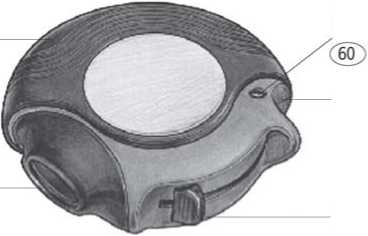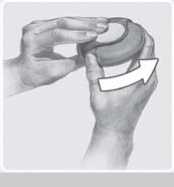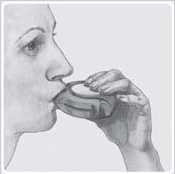Seretide 100 Accuhaler
Out of date information, search anotherImportant information about some of the ingredients of Seretide
Seretide Accuhaler contains up to 12.5 milligrams of lactose in each dose. The amount of lactose in this medicine does not normally cause problems in people who are lactose intolerant.
(salmeterol, fluticasone propionate)
Outer Case
Mouthpiece
Counter

Thumbgrip
Lever
The products name is Seretide 100 Accuhaler but it will be referred to as Seretide throughout the remainder of this leaflet.
Other strengths of this product are also available.
Read all of this leaflet carefully before you start taking this medicine.
• Keep this leaflet. You may need to read it again.
• If you have any further questions, ask your doctor or pharmacist.
• This medicine has been prescribed for you. Do not pass it on to others. It may harm them, even if their symptoms are the same as yours.
• If any of the side effects gets serious, or if you notice any side effects not listed in this leaflet, please tell your doctor or pharmacist.
In this leaflet:
1. What Seretide is and what it is used for
2. Before you use Seretide
3. How to use Seretide
4. Possible side effects
5. How to store Seretide
6. Further information
Seretide contains two medicines, salmeterol and fluticasone propionate:
• Salmeterol is a long-acting bronchodilator. Bronchodilators help the airways in the lungs to stay open. This makes it easier for air to get in and out. The effects last for at least 12 hours.
• Fluticasone propionate is a corticosteroid which reduces swelling and irritation in the lungs.
The doctor has prescribed this medicine to help prevent breathing problems such as:
• Asthma
• Chronic Obstructive Pulmonary Disease (COPD). Seretide Accuhaler, at a dose of 50/500 micrograms, reduces the number of flare ups of COPD symptoms.
You must use Seretide every day as directed by your doctor. This will make sure that it works properly in controlling your asthma or COPD.
Seretide helps to stop breathlessness and wheeziness coming on. It does not work once you are breathless or wheezy. If that happens you need to use a fast acting ‘reliever’ medication, such as salbutamol.
• Use your Seretide every day, until your doctor advises you to stop.
• Always use Seretide exactly as your doctor has told you.
Don't exceed the recommended dose. Check with your doctor or pharmacist if you're not sure.
For asthma
Adults and adolescents aged 12 years and over
• Seretide 100 Accuhaler - One inhalation twice a day
• Seretide 250 Accuhaler - One inhalation twice a day
• Seretide 500 Accuhaler - One inhalation twice a day
Children 4 to 12 years of age
• Seretide 100 Accuhaler - One inhalation twice a day
• Seretide is not recommended for use in children below 4 years of age.
For adults with Chronic Obstructive Pulmonary Disease (COPD)
• Seretide 500 Accuhaler - One inhalation twice a day
Your symptoms may become well controlled using Seretide twice a day.
If so, your doctor may decide to reduce your dose to once a day. The dose may change to:
• once at night - if you have night-time symptoms
• once in the morning - if you have daytime symptoms.
It is very important to follow your doctor's instructions on how many inhalations to take and how often to take your medicine.
If you are using Seretide for asthma, your doctor will want to regularly check your symptoms.
If your asthma or breathing gets worse, tell your doctor straight away.
You may find that you feel more wheezy, your chest feels tight more often or you may need to use more of your fast acting ‘reliever' medicine. If any of these happen, you should continue to take Seretide but do not increase the number of puffs you take. Your chest condition may be getting worse and you could become seriously ill. See your doctor as you may need additional treatment.
Instructions for use
• Your doctor, nurse or pharmacist should show you how to use your inhaler. They should check how you use it from time to time. Not using the Seretide Accuhaler properly or as prescribed may mean that it will not help your asthma or COPD as it should.
• The Accuhaler device holds blisters containing Seretide as a powder.
• There is a counter on top of the Accuhaler which tells you how many doses are left. It counts down to 0. The numbers 5 to 0 will appear in red to warn you when there are only a few doses left.
Once the counter shows 0, your inhaler is empty.
Do not take Seretide if:
You are allergic (hypersensitive) to salmeterol xinafoate, fluticasone propionate or to the other ingredient lactose monohydrate.
Take special care with Seretide
Your doctor will supervise your treatment more closely if you have medical conditions such as:
• heart disease, including an irregular or fast heartbeat
• overactive thyroid gland
• high blood pressure
• diabetes mellitus (Seretide may increase your blood sugar)
• low potassium in your blood
• Tuberculosis (TB) now, or in the past.
If you have ever had any of these conditions, tell your doctor before you use Seretide.
Taking other medicines
Please tell your doctor or pharmacist if you are taking or have recently taken any other medicines. This includes medicines for asthma or any medicines obtained without a prescription. This is because Seretide may not be suitable to be taken with some other medicines.
Tell your doctor if you are taking the following medicines, before starting to use Seretide:
• Beta-blockers (such as atenolol, propranolol and sotalol). Beta-blockers are mostly used for high blood pressure or other heart conditions.
• Antiviral and antifungal medicines (such as ritonavir, ketoconazole and itraconazole). Some of these medicines may increase the amount of fluticasone propionate or salmeterol in your body. This can increase your risk of experiencing side effects with Seretide, including irregular heartbeats, or may make side effects worse.
• Corticosteroids (by mouth or by injection). If you have had these medicines recently, this might increase the risk of this medicine affecting your adrenal gland.
Pregnancy and breast-feeding
If you are pregnant, planning to get pregnant, or breast-feeding, talk to your doctor before taking Seretide. Your doctor will assess whether you can take Seretide during this time.
Driving and using machines
Seretide is not likely to affect your ability to drive or use machines.
Using your inhaler
1 To open your Accuhaler, hold the outer case in one hand and put the thumb of your other hand on the thumbgrip. Push your thumb away from you as far as it will go. You will hear a click. This will open a small hole in the mouthpiece.

2 Hold your Accuhaler with the mouthpiece towards you. You can hold it in either your right or left hand. Slide the lever away from you as far as it will go. You will hear a click. This places a dose of your medicine in the mouthpiece.
t

Every time the lever is pulled back a blister is opened inside and the powder made ready for you to inhale. Do not play with the lever as this opens the blisters and wastes medicine.
3 Hold the Accuhaler away from your mouth, breathe out as far as is comfortable. Do not breathe into your Accuhaler.
4 Put the mouthpiece to your lips; breathe in steadily and deeply through the Accuhaler, not through your nose.
Remove the Accuhaler from your mouth.
Hold your breath for about 10 seconds or for as long as is comfortable.
Breathe out slowly.
5 Afterwards rinse your mouth with water and spit it out. This may help to stop you getting thrush and being hoarse.
6 To close the Accuhaler, slide the thumbgrip back towards you, as far as it will go. You will hear a click.
The lever will return to its original position and is reset.
Your Accuhaler is now ready for you to use again.


POM
Cleaning your inhaler
Wipe the mouthpiece of the Accuhaler with a dry tissue to clean it.
If you use more Seretide than you should
It is important to use the inhaler as instructed. If you accidentally take a larger dose than recommended, talk to your doctor or pharmacist. You may notice your heart beating faster than usual and that you feel shaky. You may also have a headache, muscle weakness and aching joints.
If you have used larger doses for a long period of time, you should talk to your doctor or pharmacist for advice. This is because larger doses of Seretide may reduce the amount of steroid hormones produced by the adrenal gland.
If you forget to use Seretide
If you forget to use your inhaler, take your next dose when it is due. Do not take a double dose to replace the one you forgot.
If you stop using Seretide
It is very important that you take your Seretide every day as directed. Keep taking it until your doctor tells you to stop. Do not stop or suddenly reduce your dose of Seretide. This could make your breathing problem worse and very rarely side effects could occur. These include:
• Stomach pain
• Tiredness and loss of appetite
• Sickness and diarrhoea
• Weight loss
• Headache or drowsiness
• Low levels of potassium in your blood
• Low blood pressure and seizures
Very rarely, if you get an infection or at times of extreme stress (such as after a serious accident or if you have surgery), you may get similar side effects.
To prevent these symptoms occurring, your doctor may prescribe extra corticosteroids (like prednisolone).
If you have any further questions on using the inhaler, ask your doctor or pharmacist.
4. Possible side effects
Like all medicines, Seretide can cause side effects, although not everybody gets them. To reduce the chance of side effects, your doctor will prescribe the lowest dose of Seretide to control your asthma or COPD.
Allergic reactions: you may notice your breathing suddenly gets worse after using Seretide. You may be very wheezy and cough. You may also notice itching and swelling (usually of the face, lips, tongue, or throat). If you get these effects or if they happen suddenly after using Seretide, tell your doctor straight away. Allergic reactions to Seretide are uncommon (they affect less than 1 person in 100).
Other side effects are listed below:
Very Common (affects more than 1 person in 10)
• Headache - this usually gets better as treatment continues.
• Increased number of colds have been reported in patients with COPD.
Common (affects less than 1 person in 10)
• Thrush (sore, creamy-yellow, raised patches) in the mouth and throat. Also sore tongue and hoarse voice. Rinsing your mouth out with water and spitting it out immediately after taking each puff may help. Your doctor may prescribe an anti fungal medication to treat the thrush.
• Aching, swollen joints and muscle pain.
The following side effects have also been reported in patients with Chronic Obstructive Pulmonary Disease (COPD):
• Pneumonia and bronchitis (lung infection). Tell your doctor if you notice any of the following symptoms: increase in sputum production, change in sputum colour, fever, chills, increased cough, increased breathing problems.
• Bruising and fractures.
• Inflammation of sinuses (a feeling of tension or fullness in the nose, cheeks and behind the eyes, sometimes with a throbbing ache).
• A reduction in the amount of potassium in the blood (you may get an uneven heart beat, muscle weakness, cramp).
Uncommon (affects less than 1 person in 100)
• Very fast heartbeat (tachycardia).
• Feeling shaky and fast or uneven heart beat (palpitations) - these are usually harmless and get less as treatment continues.
• Chest pain.
• Muscle cramps.
• Feeling worried (this effect mainly occurs in children).
• Throat irritation. Rinsing your mouth out with water and spitting it out immediately after taking each puff may help.
Rare (affects less than 1 person in 1000)
• Breathing difficulties or wheezing that get worse straight after taking Seretide. If this happens stop using your Seretide Inhaler. Use your fastacting ‘reliever' inhaler to help your breathing and tell your doctor straight away.
• Seretide may affect the normal production of steroid hormones in the body, particularly if you have taken high doses for long periods of time. The effects includes:
- slowing of growth in children and adolescents
- thinning of the bones
- cataract and glaucoma
- weight gain
- rounded (moon shaped) face (Cushing's Syndrome).
Your doctor will check you regularly for any of these side effects and make sure you are taking the lowest dose of Seretide to control your asthma.
• Increases in the amount of sugar (glucose) in your blood (hyperglycaemia). If you have diabetes, more frequent blood sugar monitoring and possibly adjustment of your usual diabetic treatment may be required.
• Disturbed sleep and behavioural changes, such as being unusually active and irritable (these effects mainly occur in children).
• Uneven heartbeat or heart gives an extra beat (arrhythmias). Tell your doctor, but do not stop taking Seretide unless they tell you to stop.
• Rash.
Frequency not known, but may also occur:
• Depression or aggression. These effects are more likely to occur in children.
If any of the side effects become serious, or if you notice any side effects not
listed in this leaflet, please tell your doctor or pharmacist.
5. How to store Seretide
• Keep out of the sight and reach of children.
• Do not store above 30°C.
• Do not use Seretide after the expiry date which is stated on the label and carton. The expiry date refers to the last day of that month.
If the medicine becomes discoloured or shows any other signs of deterioration, you should seek the advice of your pharmacist who will advice you what to do.
Medicines should not be disposed of via waste water or household waste. Ask your pharmacist how to dispose of medicines no longer required. These measures will help to protect the environment.
6. Further information
What Seretide Accuhaler contains
• Each blister contains powder for inhalation providing 50 micrograms salmeterol (as salmeterol xinafoate) and 100 micrograms of fluticasone propionate.
• The other ingredient is lactose monohydrate (which contains milk proteins).
What Seretide Accuhaler looks like and the contents of the pack
• Seretide Accuhaler is a two-tone purple, circular inhalation device in moulded plastic containing a foil blister strip containing white inhalation powder with a dose counter indicating the number of does remaining.
• The foil protects the powder for inhalation from the effects of the atmosphere.
• Each dose is pre-dispensed.
• The devices are packed in cartons which hold one Accuhaler containing 60 blisters.
Manufacturer
This product is manufactured by Glaxo Wellcome Operations, Priory Street,
Ware, Hertfordshire, SG12 0DJ, United Kingdom. Procured from within the EU
and repackaged by Mediwin Ltd., Product Licence Holder: Mediport Ltd.,
13 Martello Enterprise Centre, Courtwick Lane, Littlehampton, West Sussex,
BN17 7PA, United Kingdom.
PL No: 18980/0817
SERETIDE AND ACCUHALER ARE TRADEMARKS OF THE GLAXOSMITHKLINE GROUP OF COMPANIES.
Date of leaflet preparation: 04/01/2013
REF:
MCP-0817-S0002